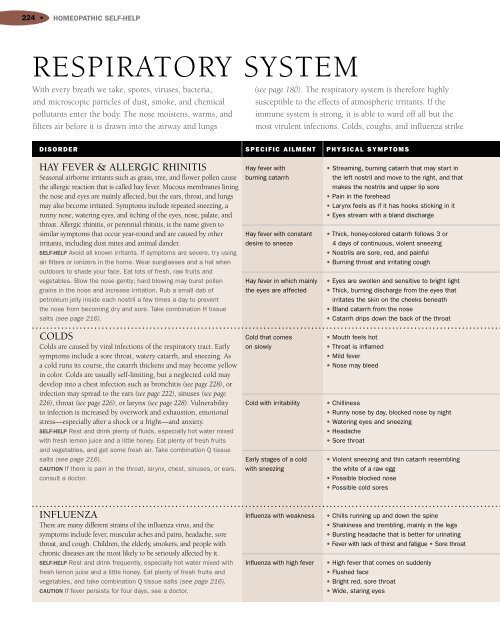Encyclopedia of Homeopathy
Encyclopedia of Homeopathy
Encyclopedia of Homeopathy
Create successful ePaper yourself
Turn your PDF publications into a flip-book with our unique Google optimized e-Paper software.
224 •HOMEOPATHIC SELF-HELPRESPIRATORY SYSTEMWith every breath we take, spores, viruses, bacteria,and microscopic particles <strong>of</strong> dust, smoke, and chemicalpollutants enter the body. The nose moistens, warms, andfilters air before it is drawn into the airway and lungs(see page 180). The respiratory system is therefore highlysusceptible to the effects <strong>of</strong> atmospheric irritants. If theimmune system is strong, it is able to ward <strong>of</strong>f all but themost virulent infections. Colds, coughs, and influenza strikeDISORDERHAY FEVER & ALLERGIC RHINITISSeasonal airborne irritants such as grass, tree, and flower pollen causethe allergic reaction that is called hay fever. Mucous membranes liningthe nose and eyes are mainly affected, but the ears, throat, and lungsmay also become irritated. Symptoms include repeated sneezing, arunny nose, watering eyes, and itching <strong>of</strong> the eyes, nose, palate, andthroat. Allergic rhinitis, or perennial rhinitis, is the name given tosimilar symptoms that occur year-round and are caused by otherirritants, including dust mites and animal dander.SELF-HELP Avoid all known irritants. If symptoms are severe, try usingair filters or ionizers in the home. Wear sunglasses and a hat whenoutdoors to shade your face. Eat lots <strong>of</strong> fresh, raw fruits andvegetables. Blow the nose gently; hard blowing may burst pollengrains in the nose and increase irritation. Rub a small dab <strong>of</strong>petroleum jelly inside each nostril a few times a day to preventthe nose from becoming dry and sore. Take combination H tissuesalts (see page 216).COLDSColds are caused by viral infections <strong>of</strong> the respiratory tract. Earlysymptoms include a sore throat, watery catarrh, and sneezing. Asa cold runs its course, the catarrh thickens and may become yellowin color. Colds are usually self-limiting, but a neglected cold maydevelop into a chest infection such as bronchitis (see page 228), orinfection may spread to the ears (see page 222), sinuses (see page226), throat (see page 226), or larynx (see page 228). Vulnerabilityto infection is increased by overwork and exhaustion, emotionalstress—especially after a shock or a fright—and anxiety.SELF-HELP Rest and drink plenty <strong>of</strong> fluids, especially hot water mixedwith fresh lemon juice and a little honey. Eat plenty <strong>of</strong> fresh fruitsand vegetables, and get some fresh air. Take combination Q tissuesalts (see page 216).CAUTION If there is pain in the throat, larynx, chest, sinuses, or ears,consult a doctor.SPECIFIC AILMENTHay fever withburning catarrhHay fever with constantdesire to sneezeHay fever in which mainlythe eyes are affectedCold that comeson slowlyCold with irritabilityEarly stages <strong>of</strong> a coldwith sneezingPHYSICAL SYMPTOMS• Streaming, burning catarrh that may start inthe left nostril and move to the right, and thatmakes the nostrils and upper lip sore• Pain in the forehead• Larynx feels as if it has hooks sticking in it• Eyes stream with a bland discharge• Thick, honey-colored catarrh follows 3 or4 days <strong>of</strong> continuous, violent sneezing• Nostrils are sore, red, and painful• Burning throat and irritating cough• Eyes are swollen and sensitive to bright light• Thick, burning discharge from the eyes thatirritates the skin on the cheeks beneath• Bland catarrh from the nose• Catarrh drips down the back <strong>of</strong> the throat• Mouth feels hot• Throat is inflamed• Mild fever• Nose may bleed• Chilliness• Runny nose by day, blocked nose by night• Watering eyes and sneezing• Headache• Sore throat• Violent sneezing and thin catarrh resemblingthe white <strong>of</strong> a raw egg• Possible blocked nose• Possible cold soresINFLUENZAThere are many different strains <strong>of</strong> the influenza virus, and thesymptoms include fever, muscular aches and pains, headache, sorethroat, and cough. Children, the elderly, smokers, and people withchronic diseases are the most likely to be seriously affected by it.SELF-HELP Rest and drink frequently, especially hot water mixed withfresh lemon juice and a little honey. Eat plenty <strong>of</strong> fresh fruits andvegetables, and take combination Q tissue salts (see page 216).CAUTION If fever persists for four days, see a doctor.Influenza with weaknessInfluenza with high fever• Chills running up and down the spine• Shakiness and trembling, mainly in the legs• Bursting headache that is better for urinating• Fever with lack <strong>of</strong> thirst and fatigue • Sore throat• High fever that comes on suddenly• Flushed face• Bright red, sore throat• Wide, staring eyes
















